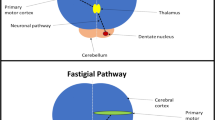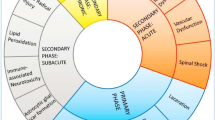Summary
We recorded spinal cord evoked potentials (SCEPs) and spinal somatosensory evoked potentials (spinal SEPs) in 30 operations following stimulation of the epidural spinal cord and the peripheral nerve, respectively, to compare their feasibility as an intraoperative technique for spinal cord monitoring. SCEPs produced quicker responses and had larger amplitudes with simpler waveforms. SCEPs could reflect residual function of the pathological spinal cord and predict the postoperative clinical outcome, findings which are not observed with spinal SEPs. Moreover, SCEPs had a much higher sensitivity to spinal cord insult. Therefore, we conclude that the SCEPs were more appropriate indicator than the spinal SEPs as an intra-operative monitoring method for spinal cord function.
Similar content being viewed by others
References
Berić A, Dimitrijević MR, Sharkey PC, Sherwood AM (1986) Electroenceph Clin Neurophysiol 65: 102–111
Bradshaw K, Webb JK, Fraser AM (1984) Clinical evaluation of spinal cord monitoring in scoliosis surgery. Spine 9: 636–643
Dinner DS, Lüders H, Lesser RP, Morris HH (1986) Invasive methods of somatosensory evoked potential monitoring. J Clin Neurophysiol 3: 113–130
Epstein F, Wishoff J (1987) Intra-axial tumors of the cervicomedullary junction. J Neurosurg 67: 483–487
Ertekin C, Sarica Y, Üşkardesler L (1984) Somatosensory cervical potentials evoked by stimulation of the lumbo-sacral spinal cord in normal subjects and in patients with conus medullaris and cauda equina lesions. Electroenceph Clin Neurophysiol 59: 57–66
Friedman WA, Richards R (1988) Somatosensory evoked potential monitoring accurately predicts hemi-spinal cord damage: a case report. Neurosurgery 22: 140–142
Halonen JP, Jones SJ, Edgar MA, Ransford AO (1989) Conduction properties of epidurally recorded spinal cord potentials following lower limb stimulation in man. Electroenceph Clin Neurophysiol 74: 161–174
Jones SJ, Edgar MA, Ransford AO (1982) Sensory nerve conduction in the human spinal cord: epidural recordings made during scoliosis surgery. J Neurol Neurosurg Psychiatry 45: 446–451
Jones SJ, Edgar MA, Ransford AO, Thomas NP (1983) A system for the electrophysiological monitoring of the spinal cord during operations for scoliosis. J Bone Joint Surg (Br) 65B: 134–139
Lueders H, Gurd A, Hahn J, Andrish J, Weiker G, Klem G (1982) A new technique for intraoperative monitoring of spinal cord function. Spine 7: 110–115
Machida M, Weinstein SL, Yamada T, Kimura J (1985) Spinal cord monitoring. Electrophysiological measures of sensory and motor function during spinal surgery. Spine 10: 407–413
Macon JB, Poletti CE (1982) Conducted somatosensory evoked potentials during spinal surgery. Part 1: Control conduction velocity measurements. J Neurosurg 57: 349–353
Macon JB, Poletti CE, Sweet WH, Ojemann RG, Zervas NT (1982) Conducted somatosensory evoked potentials during spinal surgery. Pars 2: Clinical applications. J Neurosurg 57: 354–359
Morioka T, Fujii K, Tobimatsu S, Fukui M, Sakaguchi Y (1991) Usefulness of epidurally evoked cortical potential monitoring during cervicomedullary glioma surgery. J Clin Monit (in press)
Mortimer JT, Shealy CN, Wheeler C (1970) Experimental non-destructive electrical stimulation of the brain and spinal cord. J Neurosurg 32: 553–559
Pudenz RH, Bullara LA, Jaques S, Hambrecht FT (1975) Electrical stimulation of brain III: The neural damage model. Surg Neurol 4: 389–400
Schramm J, Romstöck J, Watanabe F (1987) Cortical versus spinal recordings in intraoperative monitoring of space-occupying spinal lesions. In: Barber C, Blum T (eds) Evoked potentials III. The third international evoked potentials symposium, Butterworths, Boston, pp 328–334
Shimoji K, Higashi H, Kano T (1971) Epidural recording of spinal electrogram in man. Electroceph Clin Neurophysiol 30: 236–238
Takano H, Tamaki T, Noguchi T, Takakuwa K (1985) Comparison of spinal cord evoked potentials elicited by spinal cord and peripheral nerve stimulation. In: Schramm J, Jones SJ (eds) Spinal cord monitoring. Springer, Berlin Heidelberg New York Tokyo, pp 29–34
Tamaki T, Tsuji H, Inoue S, Kobayashi H (1981) The prevention of iatrogenic spinal cord injury utilizing the evoked spinal cord potential. Int Orthop (SICOT) 4: 313–317
Tamaki T, Noguchi T, Takano H, Tsuji H, Nakagawa T, Imai K, Inoue S (1984) Spinal cord monitoring as a clinical utilization of the spinal evoked potential. Clin Orthop 184: 58–64
Tsuyama N, Tsuzaki N, Kurokawa T, Imai T (1978) Clinical application of spinal cord action potential measurement. Int Orthop (SICOT) 2: 39–46
Whittle IR, Johnston IH, Besser M (1984) Spinal cord monitoring during surgery by direct recording of somatosensory evoked potentials. Technical note. J Neurosurg 60: 440–443
Whittle IR, Johnston IH, Besser M (1986) Recording of spinal somatosensory evoked potentials for intraoperative spinal cord monitoring. J Neurosurg 64: 601–612
Author information
Authors and Affiliations
Rights and permissions
About this article
Cite this article
Morioka, T., Tobimatsu, S., Fujii, K. et al. Direct spinal versus peripheral nerve stimulation as monitoring techniques in epidurally recorded spinal cord potentials. Acta neurochir 108, 122–127 (1991). https://doi.org/10.1007/BF01418519
Issue Date:
DOI: https://doi.org/10.1007/BF01418519




